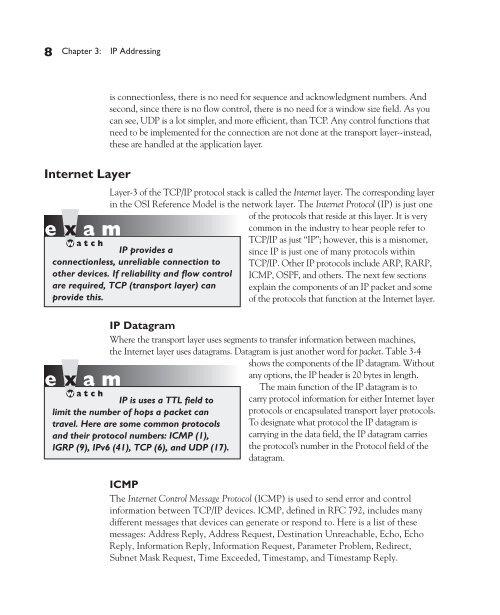ch03 IP Addressing.pdf - The Cisco Learning Network
ch03 IP Addressing.pdf - The Cisco Learning Network
ch03 IP Addressing.pdf - The Cisco Learning Network
You also want an ePaper? Increase the reach of your titles
YUMPU automatically turns print PDFs into web optimized ePapers that Google loves.
8 Chapter 3: <strong>IP</strong> <strong>Addressing</strong><br />
Internet Layer<br />
is connectionless, there is no need for sequence and acknowledgment numbers. And<br />
second, since there is no flow control, there is no need for a window size field. As you<br />
can see, UDP is a lot simpler, and more efficient, than TCP. Any control functions that<br />
need to be implemented for the connection are not done at the transport layer--instead,<br />
these are handled at the application layer.<br />
Layer-3 of the TCP/<strong>IP</strong> protocol stack is called the Internet layer. <strong>The</strong> corresponding layer<br />
in the OSI Reference Model is the network layer. <strong>The</strong> Internet Protocol (<strong>IP</strong>) is just one<br />
of the protocols that reside at this layer. It is very<br />
common in the industry to hear people refer to<br />
<strong>IP</strong> provides a<br />
connectionless, unreliable connection to<br />
other devices. If reliability and flow control<br />
are required, TCP (transport layer) can<br />
provide this.<br />
TCP/<strong>IP</strong> as just “<strong>IP</strong>”; however, this is a misnomer,<br />
since <strong>IP</strong> is just one of many protocols within<br />
TCP/<strong>IP</strong>. Other <strong>IP</strong> protocols include ARP, RARP,<br />
ICMP, OSPF, and others. <strong>The</strong> next few sections<br />
explain the components of an <strong>IP</strong> packet and some<br />
of the protocols that function at the Internet layer.<br />
<strong>IP</strong> Datagram<br />
Where the transport layer uses segments to transfer information between machines,<br />
the Internet layer uses datagrams. Datagram is just another word for packet. Table 3-4<br />
shows the components of the <strong>IP</strong> datagram. Without<br />
any options, the <strong>IP</strong> header is 20 bytes in length.<br />
<strong>The</strong> main function of the <strong>IP</strong> datagram is to<br />
<strong>IP</strong> is uses a TTL field to<br />
limit the number of hops a packet can<br />
travel. Here are some common protocols<br />
and their protocol numbers: ICMP (1),<br />
IGRP (9), <strong>IP</strong>v6 (41), TCP (6), and UDP (17).<br />
carry protocol information for either Internet layer<br />
protocols or encapsulated transport layer protocols.<br />
To designate what protocol the <strong>IP</strong> datagram is<br />
carrying in the data field, the <strong>IP</strong> datagram carries<br />
the protocol’s number in the Protocol field of the<br />
datagram.<br />
ICMP<br />
<strong>The</strong> Internet Control Message Protocol (ICMP) is used to send error and control<br />
information between TCP/<strong>IP</strong> devices. ICMP, defined in RFC 792, includes many<br />
different messages that devices can generate or respond to. Here is a list of these<br />
messages: Address Reply, Address Request, Destination Unreachable, Echo, Echo<br />
Reply, Information Reply, Information Request, Parameter Problem, Redirect,<br />
Subnet Mask Request, Time Exceeded, Timestamp, and Timestamp Reply.

















